The NVIDIA GeForce GTX 780 Ti Review
by Ryan Smith on November 7, 2013 9:01 AM ESTCompute
Jumping into compute, we’re entering the one area where GTX 780 Ti’s rule won’t be nearly as absolute. Among NVIDIA cards its single precision performance will be unchallenged, but the artificial double precision performance limitation as compared to the compute-focused GTX Titan means that GTX 780 Ti will still lose to GTX Titan whenever double precision comes into play. Alternatively, GTX 780 Ti still has to deal with the fact that AMD’s cards have shown themselves to be far more competitive in our selection of compute benchmarks.
As always we'll start with our DirectCompute game example, Civilization V, which uses DirectCompute to decompress textures on the fly. Civ V includes a sub-benchmark that exclusively tests the speed of their texture decompression algorithm by repeatedly decompressing the textures required for one of the game’s leader scenes. While DirectCompute is used in many games, this is one of the only games with a benchmark that can isolate the use of DirectCompute and its resulting performance.
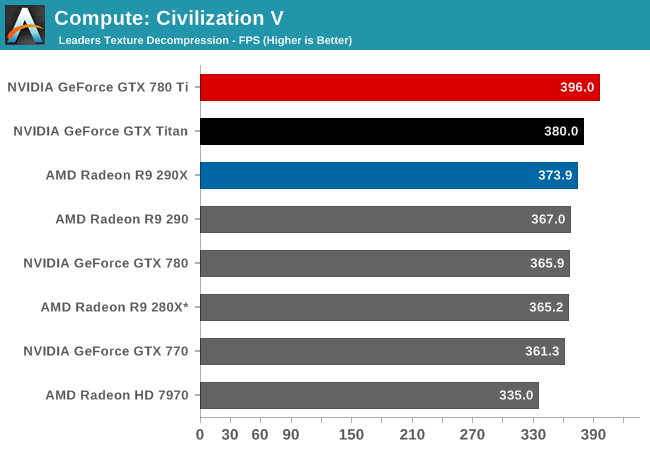
Even though we’re largely CPU bound by this point, GTX 780 Ti manages to get a bit more out of Civilization V’s texture decode routine, pushing it to the top of the charts and ahead of both GTX Titan and 290X.
Our next benchmark is LuxMark2.0, the official benchmark of SmallLuxGPU 2.0. SmallLuxGPU is an OpenCL accelerated ray tracer that is part of the larger LuxRender suite. Ray tracing has become a stronghold for GPUs in recent years as ray tracing maps well to GPU pipelines, allowing artists to render scenes much more quickly than with CPUs alone.
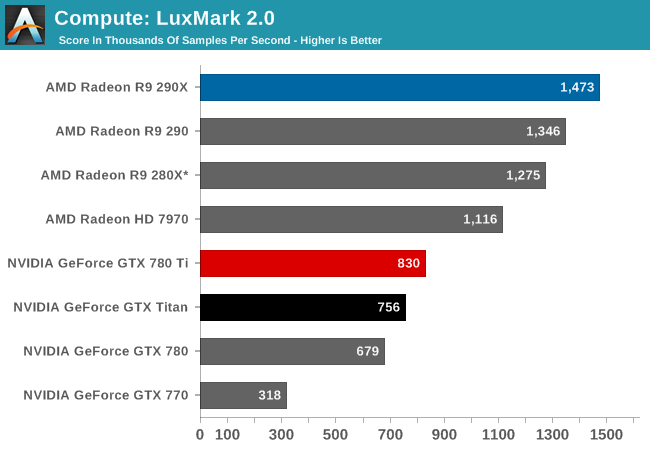
With LuxMark NVIDIA’s ray tracing performance sees further improvements due to the additional compute resources at hand. But NVIDIA still doesn’t fare well here, with the GTX 780 Ti falling behind all of our AMD cards in this test.
Our 3rd compute benchmark is Sony Vegas Pro 12, an OpenGL and OpenCL video editing and authoring package. Vegas can use GPUs in a few different ways, the primary uses being to accelerate the video effects and compositing process itself, and in the video encoding step. With video encoding being increasingly offloaded to dedicated DSPs these days we’re focusing on the editing and compositing process, rendering to a low CPU overhead format (XDCAM EX). This specific test comes from Sony, and measures how long it takes to render a video.

Like LuxMark, GTX 780 Ti once again improves on its predecessors. But it’s not enough to make up for AMD’s innate performance advantage in this benchmark, leading to GTX 780 Ti trailing all of the AMD cards.
Our 4th benchmark set comes from CLBenchmark 1.1. CLBenchmark contains a number of subtests; we’re focusing on the most practical of them, the computer vision test and the fluid simulation test. The former being a useful proxy for computer imaging tasks where systems are required to parse images and identify features (e.g. humans), while fluid simulations are common in professional graphics work and games alike.
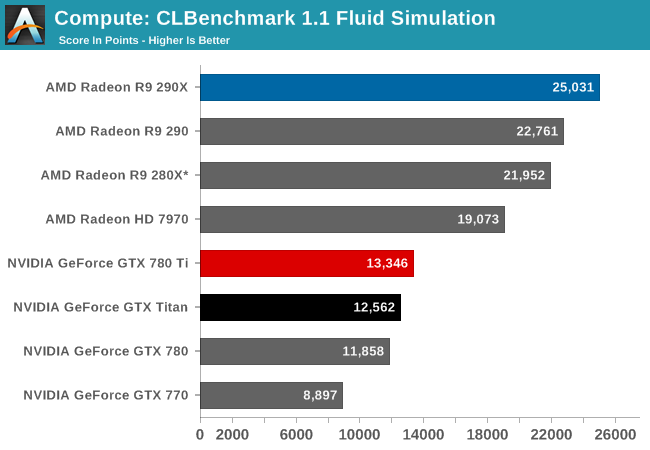
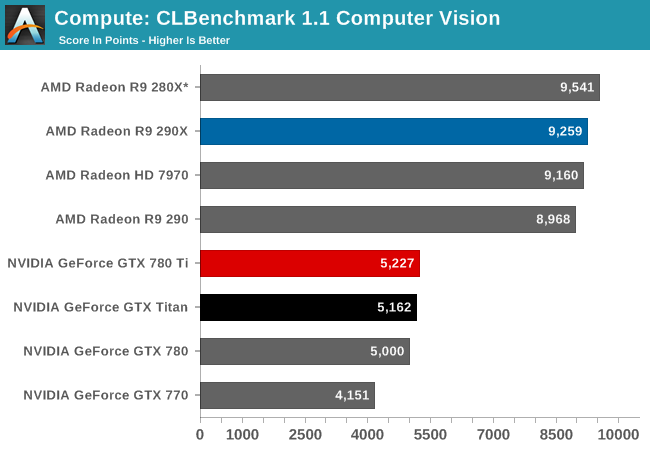
CLBenchmark continues to be the same story. GTX 780 Ti improves on NVIDIA’s performance to become their fastest single precision card, but it still falls short of every AMD card in these tests.
Moving on, our 5th compute benchmark is FAHBench, the official Folding @ Home benchmark. Folding @ Home is the popular Stanford-backed research and distributed computing initiative that has work distributed to millions of volunteer computers over the internet, each of which is responsible for a tiny slice of a protein folding simulation. FAHBench can test both single precision and double precision floating point performance, with single precision being the most useful metric for most consumer cards due to their low double precision performance. Each precision has two modes, explicit and implicit, the difference being whether water atoms are included in the simulation, which adds quite a bit of work and overhead. This is another OpenCL test, as Folding @ Home has moved exclusively to OpenCL this year with FAHCore 17.

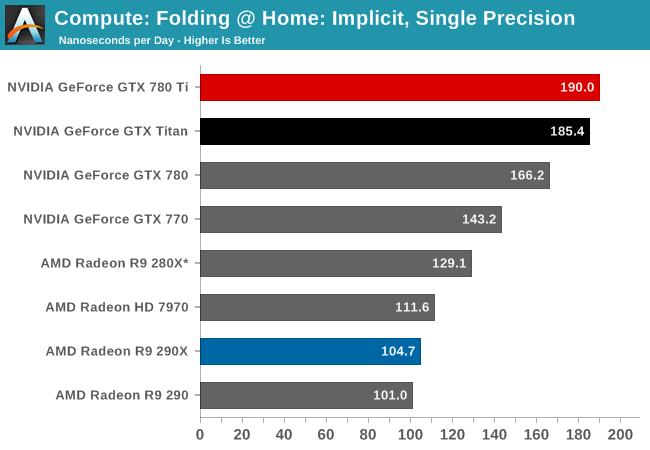
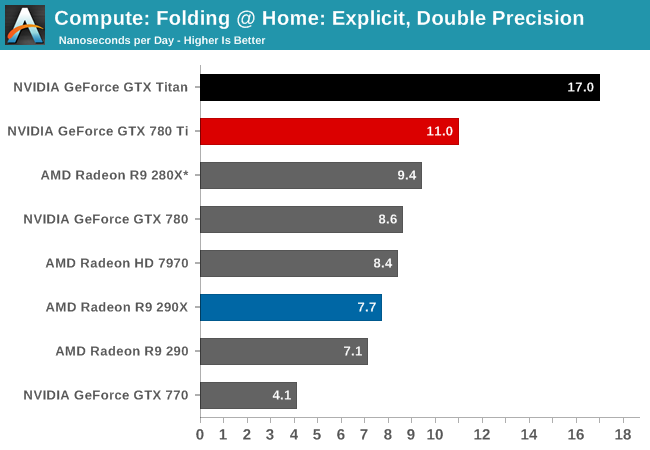
Finally with Folding@Home we see the GTX 780 Ti once again take the top spot. In the single precision tests the GTX 780 further extends NVIDIA’s lead, beating GTX Titan by anywhere between a few percent to over ten percent depending on which specific test we’re looking at. However even with GTX 780 Ti’s general performance increase, in the double precision test it won’t overcome the innate double precision performance deficit it faces versus GTX Titan. When it comes to double precision compute, Titan remains king.
Wrapping things up, our final compute benchmark is an in-house project developed by our very own Dr. Ian Cutress. SystemCompute is our first C++ AMP benchmark, utilizing Microsoft’s simple C++ extensions to allow the easy use of GPU computing in C++ programs. SystemCompute in turn is a collection of benchmarks for several different fundamental compute algorithms, as described in this previous article, with the final score represented in points. DirectCompute is the compute backend for C++ AMP on Windows, so this forms our other DirectCompute test.
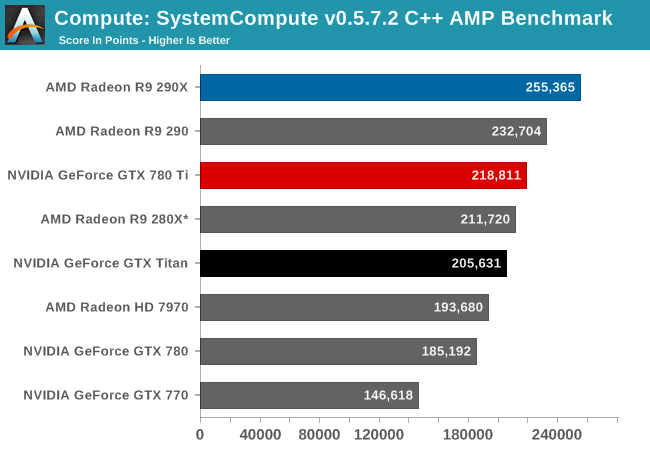
Last, in our C++ AMP benchmark we see the GTX 780 Ti take the top spot for an NVIDIA card, but like so many of our earlier compute tests it will come up short versus AMD’s best cards. This isn’t quite as lopsided as some of our other tests, however GTX 780 Ti is stuck competing with the 280X while the 290 and 290X easily outperform NVIDIA’s new flagship.










302 Comments
View All Comments
beck2448 - Tuesday, November 12, 2013 - link
They live in a dream world. Pros buy Nvidia 80% plus. That says everything about quality and reliability.Mondozai - Friday, December 13, 2013 - link
EJS, the buttboy for Nvidia, most sane people are non-fanboys.This means most people, including myself, skipped AMD the last few generations because they did a shitty job. We bought Nvidia hardware instead. Now, the roles will be changed with aftermarket coolers.
Also, please don't talk about mouthbreathers when you're literally chewing cowshit in your mouth everytime you're trying to say something. It stinks.
xdesire - Saturday, November 9, 2013 - link
You really don't know what you are talking about. Obviously, R9 290 holds great price/performance value but GTX 780 Ti has great OC potential out of the box. I'm afraid AMD shot themselves on their own foot with this reference coolerGrugtuck - Friday, November 8, 2013 - link
Any reason why the 900000000 pound gorilla in the room isnt mentioned here? 290x spanks the living **** out of the 780i in CF vs SLI. It makes me think that driver issues are still not fully sorted out.Ryan you sound like an absolute idiot when you say that no one is going to need SLI or CF any more. I also think its interesting how these days suddenly 60FPS is the standard to live by when it comes to FPS. I started playing PC games competitively back around 2002 and 80FPS has always been what people shot for, not 60. 60 is the bar min for acceptable smooth play, its not the optimal for competitive or serious FPShooter gaming.
lostsanityreturned - Saturday, November 9, 2013 - link
Hmmm I figured I would run a quick bench... my OCed 780 gigabyte with stock cooling gets the same average fps as their OCed 780ti in metro... 67fps 1440p high preset.I imagine it would be even higher if I uninstall comodo (which seems to drop my average fps by 5-14 frames just by being installed even if everything is disabled and profiles are set up correctly to ignore games, goes right back up if uninstalled though)
I hit 77degrees after my third run and it dropped back down to 75 soon after when the fans ramped up again, keeping in mind this is Western Australia I am in currently at 34 degrees (that is 94.2 Fahrenheit), all the windows open and no air-conditioning with an aircooled case.
It isn't even a demanding overclock +161 to core and +189 to memory... which considering I usually run it at +181 and +201 with ease and stability (I turned it down to see what the results were for an easy overclock as they didn't push their 780ti much)
I was feeling like crap about them releasing a new card just 4=5months after I got the 780... now... not so
sf101 - Saturday, November 9, 2013 - link
I think obviously people are just irate with Nvidia thinking they can charge premiums on everything and not just small premiums but they seem really set on this +750$ area pricing refusing to cut their customer base a break on the overpricing.So they drop down the 780 GTX to 500$ and everyone cheers "ignorantly" !!! Really its just a smoke screen because they knew the 290 and 290x were out performing their card while running on poor performing cooling units and yet it still has a $100 premium over the 290 which also out runs it pretty much everywhere.
Now down come's the 780TI pooping all over early adopters of the 780 and more so the titan buyers who thought they were getting a flagship card and foolishly paid $1000+ for them.
But its not all bad because heck man performance is performance and the 780ti is obviously needed to keep Nvidia in this race so we all look past its release but can't look past its premium pricing which is just another rip off of the customers @ 150$ over the competitor's pricing which closely competes at lower resolutions and fails to out perform @ 4k and in SLI/crossfire configurations.
Now all that would be just business as usual if Reviewer's were Educating about AMD's crossfire and high resolution performance wins over even the new and improved 780TI.
Instead they are quiet as a mouse to All AMD's Wins aside from pricing because well that's obvious and hard to ignore right. and rip AMD a new one over the downsides aka heat and noise which is totally justified and expected.
While for the nvidia side of things its all Christmas and Win's on the review reading in such a way that the 780ti wins in every category. failing to mention the Wattage use is getting up there as well as heat and fan noise, perhaps not up to 290x height's but much further than the GTX780.
All of these things have been pointed out on other review sites the good and the bad.
FuriousPop - Sunday, November 10, 2013 - link
lol, at the end of the day its all about target marketing.... excluding the fanboys of course. Fanboys = omg its better, faster, cooler oh oh i gotta have it. where as most normal people will analyse the cost of the GPU in relation to its performance to which if applicable to them would do other little upgrades to it/their case if need be, if it all still fits into the equation of how much to spend. etc etcdo your research, read lots of reviews, ask questions(if any) then purchase and don't look back. pretty simple.....
most of you all come here to rage and fire shots to either side (great entertainment btw) reminds me of that Halo Red Vs Blue. more like "fanboys - Red Vs Green" oh hey hey - why Red first eh eh!?
SymphonyX7 - Saturday, November 9, 2013 - link
Why exactly would I buy a GTX 780 Ti, when for a $100 more I can get TWO Radeon R9 290s in SLI and get twice the performance? The heat issue is there, but it ain't nothing an aftermarket cooler can't handle like the Accelero Xtreme 3.AMD wouldn't have flinched from the GTX 780 Ti's launch had it not been for their utterly terrible reference coolers.
SymphonyX7 - Saturday, November 9, 2013 - link
I meant Crossfire, not SLI. But you get the point. Have you seen those CF 290x vs SLI 780 Ti numbers? That's a ridiculous beatdown.TheinsanegamerN - Saturday, November 9, 2013 - link
you know, what i see from this, is that the 290x in uber mode is just as fast as the 780ti in most senarios, and is often a little faster. which should mean that the third party coolers that get slapped on these things should allow the 290x to soundly beat the 780ti. lets get the windforce 3x version of both these cards when they come out, and bench those for a more equal review.